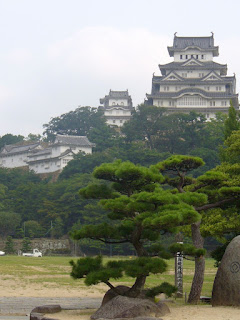Incredibly, the entire structure was rebuilt from the ground up in the 1950s, having survived unscathed since 1580. Over the years, it’s been home to 48 successive lords. It’s a wonderful structure and one of my favourite Japanese attractions. If only the heat and humidity hadn’t been so draining during our visit. We lingered at the top of the castle as much for the gentle breeze blowing through the windows, as for the view on offer.
From Himeji, a short train journey took us to Kyoto, home to more than 2000 temples and shrines. It’s the one city in Japan you should never pass without stopping. I’d planned a brief tour of at least three of the city’s most famous sights including Kinkaku-ji, Ryōan-ji, and Kiyomizu-dera. It would be fair to say that this wasn’t Garry’s favourite destination in Japan. He admitted after the first stop that temples weren’t really his thing. Half a day was more than enough time for him, while I could spend days wandering the city’s tranquil gardens and picture postcard temples.
From Kinkaku-ji was walked to Ryōan-ji, - a rather hot, sweaty walk at that. This temple belongs to the Rinzai School of Zen Buddhism. It’s famous for a rock garden consisting of nothing more than 15 rocks, arranged into islands and set in a sea of painstakingly raked white gravel. Visitors are encouraged to pause and ponder the garden’s form until it speaks to them. My most powerful memory is one of sweat running down my back, dripping off my arms and leaving rather obvious and mildly embarrassing pools at my feet.
Sadly, the colours on the temple’s pagoda and main gate were rather faded. I recall them as stunning, bright red structures in 1998. We did see a gang furiously repainting several minor temples. They clearly have a lot of work ahead of them.
As the sun began to set, we made our way to Kyoto station, catching our 2.5 hour train to Tokyo. I’d used some loyalty points to book a five-star hotel in Shinagawa, a southern suburb of Tokyo. Our hotel, the Le Meridian, boasted a large, perfectly landscaped Japanese garden complete with a fish-filled lake, waterfalls and mature trees. Nothing special you say? It is when you consider that the garden is three-floors above street-level, sitting in the heart of a commercial district that easily passes for a soulless concrete jungle.
Dinner on our first evening was spent at a local restaurant we found nearby. Garry ordered Suki-yaki, while I ordered Shabu-shabu. These are two popular Japanese meals traditionally cooked on small gas stoves brought to your table. Suki-yaki is a type of stir-fry where raw ingredients are cooked in a hot pan, while Shabu-shabu is a steaming broth in which you boil typical stir-fry ingredients. Both dishes are fun to cook and eat.
While we had plenty of fun, I suspect the restaurant staff had even more fun. I’m sure we were visited by every employee at some point, keen to either help us cook, or watch in silent bemusement as we deftly welded our chopsticks.
One of the more fascinating aspects of dining in Japan is the 3-D menu that most restaurants display in their window. Each menu item is reproduced in plastic, making it easy to identify tasty meals despite the language barrier.
















No comments:
Post a Comment